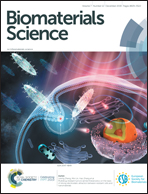Glypican-3 (GPC3) targeted Fe3O4 core/Au shell nanocomplex for fluorescence/MRI/photoacoustic imaging-guided tumor photothermal therapy†
Abstract
Low binding affinity and lack of therapy functions limit tumor targeting peptide applications in the biomedical field. Herein, we successfully modified a previous phage display derived Glypican-3 (GPC3) binding peptide (GBP) on the surface of a Fe3O4 Core/Au shell nanocomplex (FANP) to improve GBP binding affinity and enhance FANP tumor photothermal therapy (PTT) efficacy. As a result, GBP-FANP showed improved avidity to GPC-3 (Apparent Kd = 396.3 ± 70.8 nM) compared to that of GPB (Apparent Kd = 735.2 ± 53.6 nM). After intravenous administration, GBP-FANP was found specifically accumulated in GPC-3 positive HepG2 tumors and peaked at 24 h post-injection as observed by magnetic resonance imaging (MRI)/photoacoustic (PA)/fluorescent imaging. Moreover, HepG2 tumors that received GBP-FANP treatment were significantly inhibited with laser irradiation (630 nm, 1 W cm−2, 10 min). In conclusion, our present strategy provides a way of improving peptide ligand avidity with nanotechnology for cancer theranostics applications.



 Please wait while we load your content...
Please wait while we load your content...